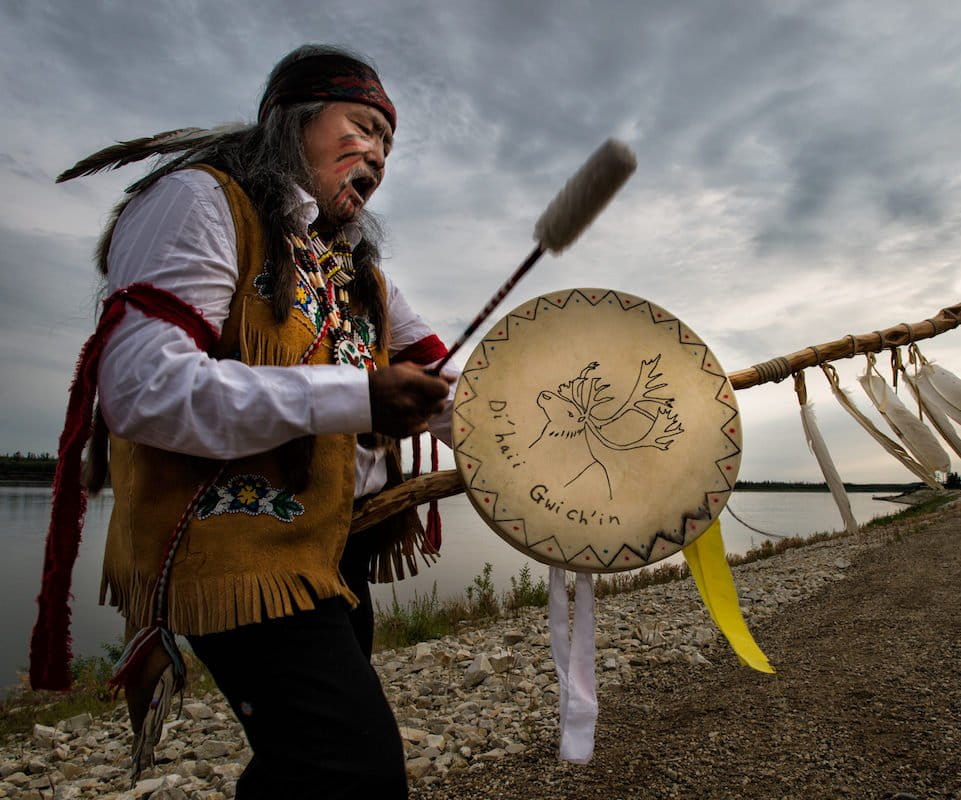- Construction of the Line 3 pipeline by Canadian oil giant Enbridge is in its final stages of completion, and is set to carry tar sands crude from Alberta to Wisconsin via lands that Indigenous Anishinaabe people use for hunting and harvesting.
- There are concerns the pipeline will contribute to further spills in the distinctive wetlands and wild rice fields of the region, as the company has a long track record of “hazardous liquid incidents,” including the largest inland oil spill in U.S. history, and failing to follow environmental laws during construction.
- Some Indigenous rights and tribal leaders view Canada’s approval and the subsequent construction of Line 3 as part of the continuing legacy of colonialism and cultural erasure, which the National Day for Truth and Reconciliation, on September 30, seeks to address.
Canadian oil company Enbridge is just hours away from completing its thousand-mile pipeline from Alberta through north Minnesota to Wisconsin, with oil set to flow the day after Canada’s first National Day for Truth and Reconciliation.
Almost five years after initially receiving approval from Canadian Prime Minister Justin Trudeau to carry the thick tar sands oil, the Line 3 pipeline zigzags between Indigenous Anishinaabe reserves in the northeastern U.S. and crosses over hundreds of biodiverse wetlands and wild rice beds. The new “substantially complete” pipeline runs 1,765 kilometers (1,097 miles) and continues to face protests and criticism on both sides of the border, as appeals and lawsuits from Indigenous, environmental and climate action groups were heard and declined over the years.
“Line 3 is a crime against the environment and Indigenous rights, waters and lands,” said Winona LaDuke, executive director of Indigenous rights organization Honor the Earth. “Enbridge has raced to build this line before the Federal court has passed judgment on our appeals about the line.”
The new pipeline is a replacement for the previous Line 3, built in 1961 and operating today with severe corrosion anomalies and at reduced pressure. The old pipeline was built and operated by Lakehead Pipeline Co., one of Enbridge’s previous corporate incarnations, and was the source of the largest inland oil spill in U.S. history. In that incident, in 1991, 7.7 million liters (1.7 million gallons) of oil spilled into the Prairie River in Grand Rapids, Minnesota.
The Minnesota Public Utilities Commission has yet to hold Enbridge accountable for removing the entirety of the old pipeline. The new pipeline follows a different path and is rated to transport up to 760,000 barrels (145 million liters, or 32 million gallons) of oil per day, with what Enbridge calls improved “environmental management” and the creation of more than 33,000 jobs on both sides of the border. Some Ojibwe bands (a specific Anishinaabe people) such as the Red Lake Nation and the White Earth Nation have continued to protest the new pipeline on the grounds that it not only unnecessarily negates Minnesota’s planned carbon reductions, but also violates the rights of Anishinaabe people inscribed in the 1855 Treaty of Washington “by endangering the primary areas of hunting, fishing, wild rice, and cultural resources” in surrounding reserves.

These fears stem from Enbridge’s long track record of environmental damages and impact on biodiversity. In 2010, a spill from the company’s Line 6B released 20,000 barrels (3.8 million liters, or 840,000 gallons) of diluted bitumen oil from Alberta into the Kalamazoo River in Michigan. The cleanup process was difficult, as the thick oil eventually sank in the water and required dredging to remove. Enbridge is also responsible for 307 reported “hazardous liquid incidents” from 2002 to 2018, amounting to a total of 66,059 barrels (12.7 million liters, or 2.8 million gallons). Currently, Enbridge is being sued for $3.32 million by the Minnesota Department of Natural Resources (DNR) for failure to follow environmental laws during construction of Line 3, and faces investigations of spilling 364 liters (80 gallons) of drilling fluid in the Willow River.
Protecting wild rice and wetlands
The north Minnesota region where the pipeline runs across is home to wild rice, a native grain that sprouts in long, lush stalks from the vast fields of wetlands that have been maintained and cultivated by the Ojibwe people for centuries. This grain is now threatened by climate change. Known as manoomin in the Ojibwe language, the wild rice’s harvesting process is a cultural tradition integral to the Ojibwe people’s identity and diet. Gatherers would nimbly maneuver through the stalks on canoes and thresh the heads on the sides of their boats, causing most of the seeds to fall into the boats and the rest to fall to the muddy water and germinate for another cycle. The White Earth Nation continues to practice and teach sustainable harvesting methods to youths and has granted the sacred rice grain rights as a living entity that it pleaded on behalf of in a lawsuit against the Line 3 pipeline.
The respondent in this lawsuit in tribal court is the Minnesota Department of Natural Resources, which permitted Enbridge to dig a trench across north Minnesota and temporarily pump out 22.7 billion liters (5 billion gallons) of groundwater to build the pipeline corridor without consulting surrounding Indigenous nations.
Three months after the DNR’s assessment that the “dewatering” process would have limited impact on wetlands, streams, lakes and the shallow aquifer, the department is now ordering Enbridge to pay for damaging an aquifer when digging deeper than permitted, with possible effects on the calcareous fens. Calcareous fens are “rare and irreplaceable” wetlands connected to larger groundwater systems that contribute to the ecological diversity of the region. They also host rare plant species, several which are endangered, such as Fimbristylis puberula, a flowering plant.
Some Indigenous and environmental rights groups continue to dispute the courts’ arguments that the environmental impact statement for the pipeline was adequate.
“Enbridge is pushing the message that the Line 3 is a done deal and that they have followed all the rules and regulations,” the Indigenous Environmental Network said in a statement issued after the substantial completion of the pipeline was announced. “[However] we see even at this late date the continuing harm to our lands and waters. There have been spills, frac outs and pierced aquifers even to this day.”

Canada’s national day of reckoning
The pipeline’s imminent operation comes against the backdrop of Canada’s first National Day for Truth and Reconciliation, Sept. 30. This new federal statutory holiday, a response to the Truth and Reconciliation Commission’s 94 calls to action, is meant to be one of reflection for the Canadian government and citizens of the nation’s colonial history of residential schools — a system accused of cultural genocide, child abuse and intergenerational trauma. This year saw the discovery of a mass grave with the remains of 215 Indigenous children from the Kamloops Indian Residential School in British Columbia.
The Line 3 pipeline has been touted by proponents as an initiative to boost Alberta’s economy and function as the environmental alternative to the oil being transported by rail. But some Indigenous rights groups see its approval and completion — through lands and wetlands that much of their culture and identity is tied to — as a continuation of a pattern of cultural erasure and colonialism in North America that the national day was meant to address. The same year the pipeline was approved in Canada, in 2016, it also received consent decree from the Obama administration’s Department of Justice and the U.S. Environmental Protection Agency.
“The drilling that Enbridge is being allowed to do here is a continuation of the same pattern of subjugation and genocide faced by Indigenous populations throughout history,” Chase Iron Eyes, co-director and lead counsel for the Lakota People’s Law Project, said in response to police clashes and arrests of Indigenous protesters in August. “Our treaties have been ignored, our children have been killed, and now our rivers are being poisoned. And when we stand up to the forces of extractive greed, we pay a heavy price.”
Though the final and fraught construction of the pipeline is occurring south of Canada’s border, many Indigenous peoples within the nation have voiced concerns for the wetlands and Indigenous communities that crisscross beyond present-day national territories. The Anishinaabe lands that the pipeline touches encompass both Canada and the U.S., straddling portions of Alberta, Saskatchewan, Ontario, Quebec, North Dakota, Minnesota and Michigan.
“Indigenous issues exist across borders and cooperation between groups, nations, and organizations is an ongoing effort,” said Elmer St. Pierre, national chief of Canada’s Congress of Aboriginal Peoples. “Reconciliation means recognition of rights. Line 3 cannot ignore the free, prior and informed consent of impacted Indigenous peoples.”
According to the United Nations Declaration on the Rights of Indigenous Peoples (UNDRIP), which the Canadian parliament moved to advance implementation of in June 2021, all Indigenous peoples have the right to give or withhold consent to a project that may affect them or their lands. Once they have given their consent, they can withdraw it at any stage.

Though UNDRIP is not binding in the U.S., many Indigenous groups feel that Canada should take the rights of Indigenous peoples there, and all around the world, into consideration before approving any projects and pipelines that impact them in the future.
“Line 3 illustrates why including all Indigenous people is crucial for any project, before it begins,” St. Pierre said.
The pipeline now stands to be “fully operational” and will let oil flow from Alberta to Wisconsin the day after Canada’s National Day for Truth and Reconciliation. Whether the timing was deliberate or coincidental, Indigenous groups involved in stopping Line 3 on both sides of the border say they will continue campaigning against new pipelines, the destruction of high-value conservation areas, and projects that don’t honor Indigenous land rights.
“In the context of our climate emergency, when Indigenous peoples stand against pipelines, we are not only standing up to protect our land rights, we are also standing up for everyone on the planet and future generations that come after us,” Iron Eyes said.
Banner image: The Gwich’in First Nation cultural gathering in Old Crow, Yukon, in 2014, where people discussed important issues such as the threat of oil and gas development. Image courtesy of Mongabay.
Related listening from Mongabay’s podcast: A conversation with Victoria Tauli-Corpuz and Zack Romo about Indigenous rights and the future of biodiversity conservation. Listen here:
FEEDBACK: Use this form to send a message to the author of this post. If you want to post a public comment, you can do that at the bottom of the page.
